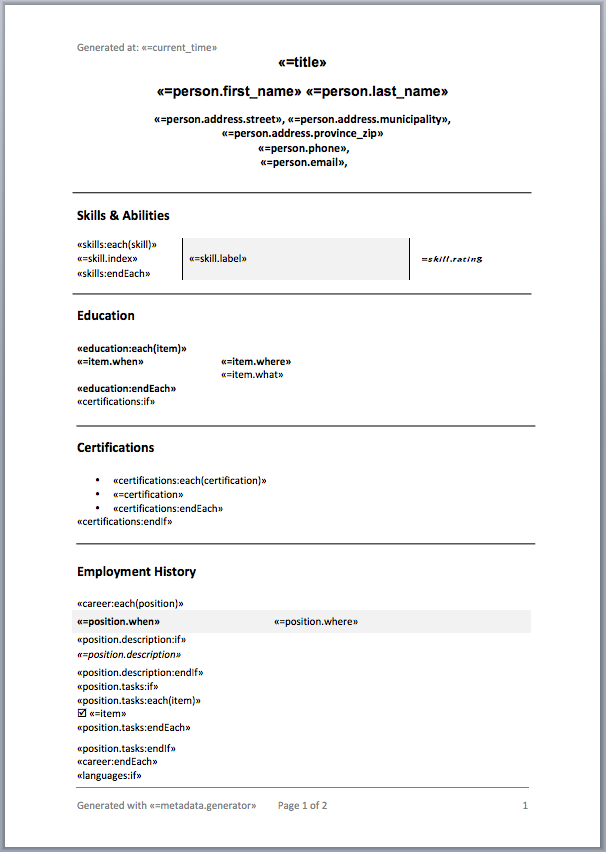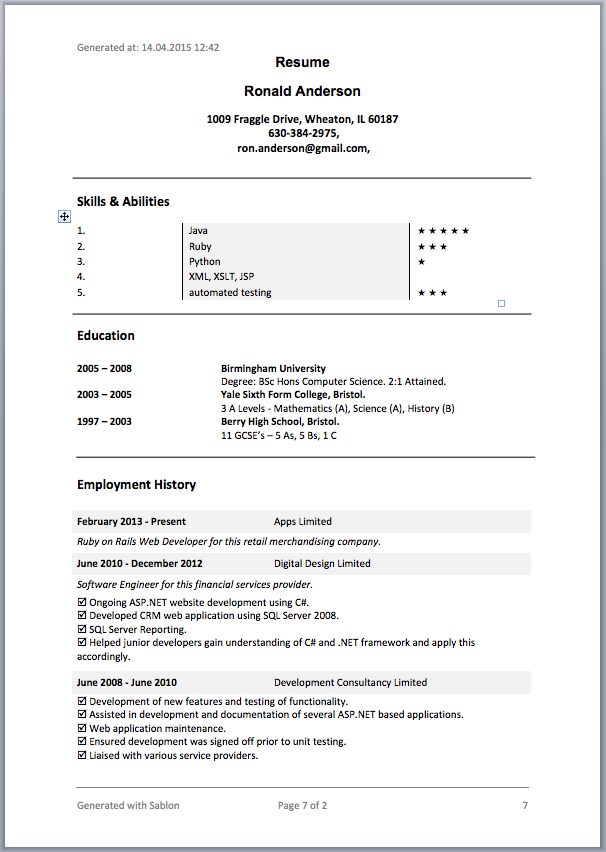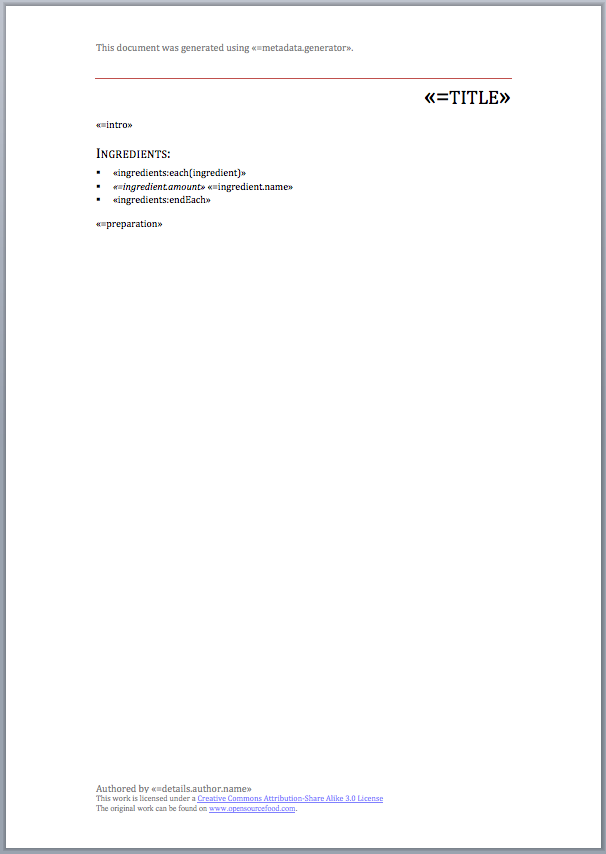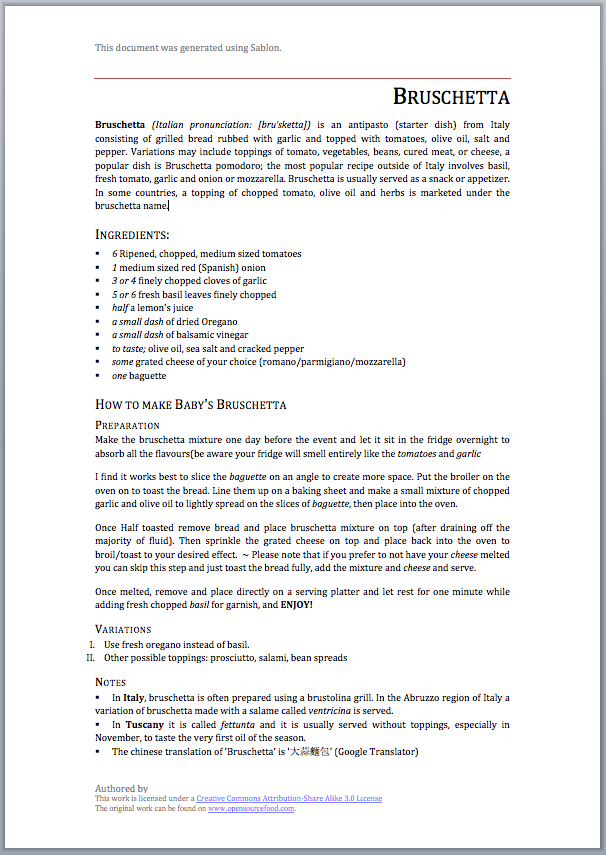Is a document template processor for Word docx files. It leverages Word's
built-in formatting and layouting capabilities to make template creation easy
and efficient.
Add this line to your application's Gemfile:
gem 'sablon'require "sablon"
template = Sablon.template(File.expand_path("~/Desktop/template.docx"))
context = {
title: "Fabulous Document",
technologies: ["Ruby", "HTML", "ODF"]
}
template.render_to_file File.expand_path("~/Desktop/output.docx"), contextSablon templates are normal Word documents (.docx) sprinkled with MailMerge fields
to perform operations. The following section uses the notation «=title» to
refer to Word MailMerge fields.
A detailed description about how to create a template can be found here
The most basic operation is to insert content. The contents of a context variable can be inserted using a field like:
«=title»
It's also possible to call a method on a context object using:
«=post.title»
NOTE: The dot operator can also be used to perform a hash lookup. This means that it's not possible to call methods on a hash instance. Sablon will always try to make a lookup instead.
This works for chained method calls and nested hash lookup as well:
«=buyer.address.street»
Generally Sablon tries to reuse the formatting defined in the template. However, there are situations where more fine grained control is needed. Imagine you need to insert a body of text containing different formats. If you can't decide the format ahead of processing time (in the template) you can insert WordProcessingML directly.
It's enough to use a simply insertion operation in the template:
«=long_description»
To insert WordProcessingML prepare the context accordingly:
word_processing_ml = <<-XML.gsub("\n", "")
<w:p>
<w:r w:rsidRPr="00B97C39">
<w:rPr>
<w:b />
</w:rPr>
<w:t>this is bold text</w:t>
</w:r>
</w:p>
XML
context = {
long_description: Sablon.content(:word_ml, word_processing_ml)
}
template.render_to_file File.expand_path("~/Desktop/output.docx"), contextIn the example above the entire paragraph will be replaced because all of the nodes being inserted aren't valid children of a paragraph (w:p) element. The example below shows inline insertion, where only runs are added and instead of replacing the entire paragraph only the merge field gets removed.
Important: All text must be wrapped in a run tag for valid inline insertion because WordML is still inserted directly into the document "as is" without any structure transformations other than run properties being merged.
word_processing_ml = <<-XML.gsub("\n", "")
<w:r w:rsidRPr="00B97C39">
<w:rPr>
<w:b />
</w:rPr>
<w:t>this is bold text</w:t>
</w:r>
XML
context = {
long_description: Sablon.content(:word_ml, word_processing_ml)
}
template.render_to_file File.expand_path("~/Desktop/output.docx"), contextSimilar to WordProcessingML it's possible to use html as input while processing the template. You don't need to modify your templates, a simple insertion operation is sufficient:
«=article»
To use HTML insertion prepare the context like so:
html_body = <<-HTML.strip
<div>
This text can contain <em>additional formatting</em> according to the
<strong>HTML</strong> specification. As well as links to external
<a href="https://github.com/senny/sablon">websites</a>, don't forget
the "http/https" bit.
</div>
<p style="text-align: right; background-color: #FFFF00">
Right aligned content with a yellow background color.
</p>
<div>
<span style="color: #123456">Inline styles</span> are possible as well
</div>
<table style="border: 1px solid #0000FF;">
<caption>Table's can also be created via HTML</caption>
<tr>
<td>Cell 1 only text</td>
<td>
<ul>
<li>List in Table - 1</li>
<li>List in Table - 2</li>
</ul>
</td>
</tr>
<tr>
<td></td>
<td>
<table style="border: 1px solid #FF0000;">
<tr><th>A</th><th>B</th></tr>
<tr><td>C</td><td>D</td></tr>
</table>
</td>
</tr>
</table>
HTML
context = {
article: Sablon.content(:html, html_body) }
# alternative method using special key format
# 'html:article' => html_body
}
template.render_to_file File.expand_path("~/Desktop/output.docx"), contextThere is no 1:1 conversion between HTML and Open Office XML however, a large number of tags are very similar. HTML insertion is relatively complete covering several key content structures such as paragraphs, tables and lists. The snippet above showcases some of the capabilities present, for a comprehensive example please see the html insertion test fixture here. All html element conversions are defined in configuration.rb with their matching AST classes defined in ast.rb.
Basic conversion of CSS inline styles into matching WordML properties is possible
using the style=" ... " attribute in the HTML markup. Not all CSS properties
are supported as only a small subset of CSS styles have a direct Open Office XML
equivalent. Styles are passed onto nested elements if the parent can't use them.
The currently supported styles are also defined in configuration.rb. Toggle
properties that aren't directly supported can be added using the
text-decoration: style attribute with the proper XML tag name as the
value (i.e. text-decoration: dstrike for w:dstrike). Simple single value properties that do not need a conversion can be added using the XML property name directly, omitting the w: prefix i.e.
(highlight: cyan for w:highlight).
Table, Paragraph and Run property references can be found at:
- http://officeopenxml.com/WPparagraphProperties.php
- http://officeopenxml.com/WPtextFormatting.php
- http://officeopenxml.com/WPtableProperties.php
The full Open Office XML specification used to develop the HTML converter can be found here (3rd Edition).
The example above shows an HTML insertion operation that will replace the entire paragraph. In the same fashion as WordML, inline HTML insertion is possible where only the merge field is replaced as long as only "inline" elements are used. "Inline" in this context does not necessarily mean the same thing as it does in CSS, in this case it means that once the HTML is converted to WordML only valid children of a paragraph (w:p) tag exist. As with WordML all plain text needs to be wrapped in a HTML tag. A simple <span>..</span> tag enclosing all other elements will suffice. See the example below:
inline_html = <<-HTML.strip
<span>This text can contain <em>additional formatting</em> according to the
<strong>HTML</strong> specification. As well as links to external
<a href="https://github.com/senny/sablon">websites</a>, don't forget
the "http/https" bit.</span>
HTML
context = {
article: Sablon.content(:html, inline_html) }
# alternative method using special key format
# 'html:article' => html_body
}
template.render_to_file File.expand_path("~/Desktop/output.docx"), contextImages can be added to the document using a placeholder image wrapped in a
pair of merge fields set up as «@figure:start» and «@figure:end». Where
in this case "figure" is the key of the context hash storing the image.
Images are wrapped in an instance of a Sablon::Content class in the same
fashion as HTML or WordML strings. An image may be initialized from multiple
sources such as file paths, URLs, or any object that exposes a #read
method that returns image data. When using a "readable object" if the object
doesn't have a #filename method then a filename: '...' option
needs to be added to the Sablon.content method call.
context = {
figure: Sablon.content(:image, 'fixtures/images/c3po.jpg'),
figure2: Sablon.content(:image, string_io_obj, filename: 'test.png')
# alternative method using special key format for simple paths and URLs
# 'image:figure' => 'fixtures/images/c3po.jpg'
}Additional examples of usage can be found in images_template.docx and in sablon_test.rb.
Sablon can render parts of the template conditionally based on the value of a context variable. Conditional fields are inserted around the content.
«technologies:if»
... arbitrary document markup ...
«technologies:endIf»
This will render the enclosed markup only if the expression is truthy.
Note that nil, false and [] are considered falsy. Everything else is
truthy.
For more complex conditionals you can use a predicate like so:
«body:if(present?)»
... arbitrary document markup ...
«body:endIf»
Finally, you can also mix in elsif and else clauses as well.
«body:if(present?)»
... arbitrary document markup ...
«body:elsif(nil?)»
... arbitrary document markup ...
[additional elsif blocks...]
«body:else»
... arbitrary document markup ...
«body:endIf»
Loops repeat parts of the document.
«technologies:each(technology)»
... arbitrary document markup ...
... use `technology` to refer to the current item ...
«technologies:endEach»
Loops can be used to repeat table rows or list enumerations. The fields need to be placed in within table cells or enumeration items enclosing the rows or items to repeat. Have a look at the example template for more details.
It is possible to nest loops and conditionals.
Sometimes it's necessary to include markup in the template that should not be visible in the rendered output. For example when defining sample numbering styles for HTML insertion.
«comment»
... arbitrary document markup ...
«endComment»
The Sablon::Configuration singleton is a new feature that allows the end user to customize HTML parsing to their needs without needing to fork and edit the source code of the gem. This API is still in a beta state and may be subject to change as future needs are identified beyond HTML conversion.
The example below show how to expose the configuration instance:
Sablon.configure do |config|
# manipulate config object
endThe default set of registered HTML tags and CSS property conversions are defined in configuration.rb.
Any HTML tag can be added using the configuration object even if it needs a custom AST class to handle conversion logic. Simple inline tags that only modify the style of text (i.e. the already supported <b> tag) can be added without an AST class as shown below:
Sablon.configure do |config|
config.register_html_tag(:bgcyan, :inline, properties: { highlight: 'cyan' })
endThe above tag simply adds a background color to text using the <w:highlight w:val="cyan" /> property.
More complex business logic can be supported by adding a new class under the Sablon::HTMLConverter namespace. The new class will likely subclass Sablon::HTMLConverter::Node or Sablon::HTMLConverter::Collection depending on the needed behavior. The current AST classes serve as additional examples and can be found in ast.rb. When registering a new HTML tag that uses a custom AST class the class must be passed in either by name using a lowercased and underscored symbol or the class object itself.
The block below shows how to register a new HTML tag that adds the following AST class: Sablon::HTMLConverter::InstrText.
module Sablon
class HTMLConverter
class InstrText < Node
# implementation details ...
end
end
end
# register tag
Sablon.configure do |config|
config.register_html_tag(:bgcyan, :inline, ast_class: :instr_text)
endExisting tags can be overwritten using the config.register_html_tag method or removed entirely using config.remove_html_tag.
# remove tag
Sablon.configure do |config|
# remove support for the span tag
config.remove_html_tag(:span)
endThe conversion of CSS stored in an element's style="..." attribute can be customized using the configuration object as well. Adding a new style conversion or overriding an existing one is done using the config.register_style_converter method. It accepts three arguments the name of the AST node (as a lowercased and underscored symbol) the style applies to, the name of the CSS property (needs to be a string in most cases) and a lambda that accepts a single argument, the property value. The example below shows how to add a new style that sets the <w:highlight /> property.
# add style conversion
Sablon.configure do |config|
# register new conversion for the Sablon::HTMLConverter::Run AST class.
converter = lambda { |v| return 'highlight', v }
config.register_style_converter(:run, 'custom-highlight', converter)
endExisting conversions can be overwritten using the config.register_style_converter method or removed entirely using config.remove_style_converter.
# remove tag
Sablon.configure do |config|
# remove support for conversion of font-size for the Run AST class
config.remove_style_converter(:run, 'font-size')
endThe sablon executable can be used to process templates on the command-line.
The usage is as follows:
cat <context path>.json | sablon <template path> <output path>
If no <output path> is given, the document will be printed to stdout.
Have a look at this test for examples.
There is a sample template in the repository, which illustrates the functionality of sablon:
Processing this template with some sample data yields the following output document. For more details, check out this test case.
The executable test showcases the sablon
executable.
The template
is rendered using a json context to provide the data. Following is the resulting output:
- Fork it ( https://github.com/senny/sablon/fork )
- Create your feature branch (
git checkout -b my-new-feature) - Commit your changes (
git commit -am 'Add some feature') - Push to the branch (
git push origin my-new-feature) - Create a new Pull Request
These projects address a similar goal and inspired the work on Sablon:




